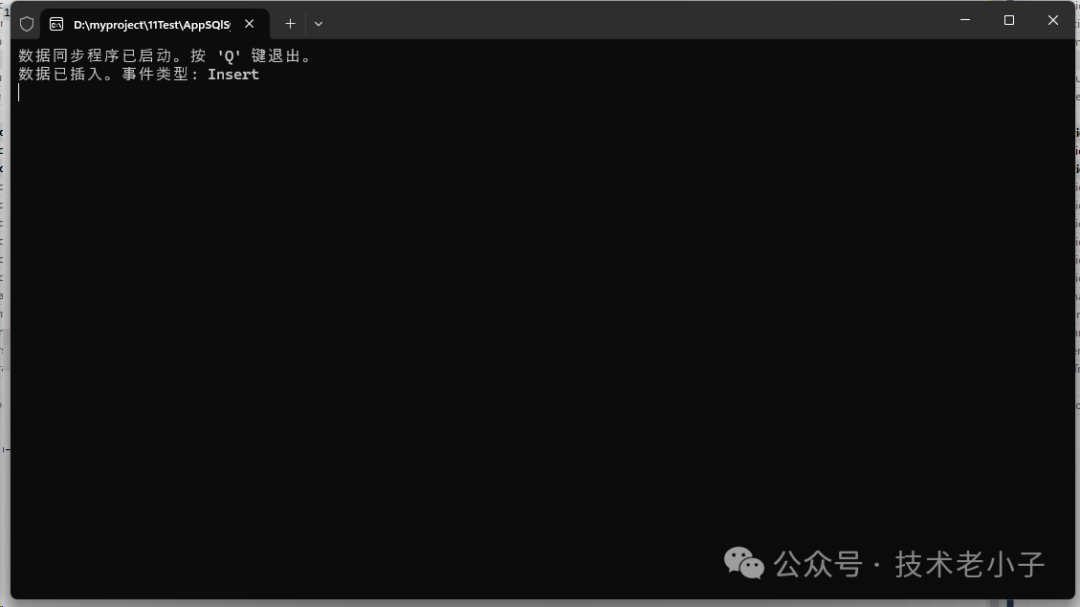在現(xiàn)代應(yīng)用程序中,及時(shí)更新不同數(shù)據(jù)庫之間的數(shù)據(jù)至關(guān)重要。本文將介紹如何在 SQL Server 中使用 C# 實(shí)現(xiàn)數(shù)據(jù)的實(shí)時(shí)同步。我們將使用 SQLDependency 類來監(jiān)聽數(shù)據(jù)庫表的變化,并將這些變化實(shí)時(shí)地同步到另一張表中。
前提條件
在開始之前,請確保已經(jīng)設(shè)置好兩個(gè) SQL Server 數(shù)據(jù)庫:
配置 SQL Server
首先,需要啟用 SQL Server 的查詢通知服務(wù),以便支持 SQLDependency。請使用以下命令啟用數(shù)據(jù)庫服務(wù)代理:
查看
SELECT name, is_broker_enabled FROM sys.databases;
ALTER DATABASE SourceDB SET ENABLE_BROKER;
編寫 C# 程序
下面的 C# 程序?qū)⑹褂?nbsp;SQLDependency 來監(jiān)聽 SourceDB 中的 SourceTable 表的變化。我們將在數(shù)據(jù)插入時(shí)同步到 TargetDB 中的 TargetTable。
程序代碼
using System;using System.Data;using System.Data.SqlClient;using System.Configuration;
class Program{ private static bool _continueRunning = true;
static void Main() { Console.WriteLine("數(shù)據(jù)同步程序已啟動(dòng)。按 'Q' 鍵退出。");
// 設(shè)置連接字符串 string sourceConnectionString = ConfigurationManager.ConnectionStrings["SourceDB"].ConnectionString; string targetConnectionString = ConfigurationManager.ConnectionStrings["TargetDB"].ConnectionString;
// 啟用 SQLDependency SqlDependency.Start(sourceConnectionString);
try { while (_continueRunning) { try { using (SqlConnection sourceConnection = new SqlConnection(sourceConnectionString)) { sourceConnection.Open(); StartListening(sourceConnection);
// 保持連接打開狀態(tài) while (_continueRunning) { if (Console.KeyAvailable) { var key = Console.ReadKey(true).Key; if (key == ConsoleKey.Q) { _continueRunning = false; break; } } Thread.Sleep(100); } } } catch (Exception ex) { Console.WriteLine($"發(fā)生錯(cuò)誤: {ex.Message}"); Console.WriteLine("5秒后重試..."); Thread.Sleep(5000); } } } finally { SqlDependency.Stop(sourceConnectionString); Console.WriteLine("數(shù)據(jù)同步程序已停止。"); } }
private static void StartListening(SqlConnection connection) { using (SqlCommand command = new SqlCommand("SELECT ID, Name, Value, Created_Time FROM dbo.t1", connection)) { SqlDependency dependency = new SqlDependency(command); dependency.OnChange += new OnChangeEventHandler(OnDataChange);
using (SqlDataReader reader = command.ExecuteReader()) { // 初次加載數(shù)據(jù)處理 } } }
private static void OnDataChange(object sender, SqlNotificationEventArgs e) { if (e.Info == SqlNotificationInfo.Insert) { Console.WriteLine("數(shù)據(jù)已插入。事件類型: " + e.Info.ToString()); SyncData(); }
// 重新啟用監(jiān)聽 string sourceConnectionString = ConfigurationManager.ConnectionStrings["SourceDB"].ConnectionString; using (SqlConnection sourceConnection = new SqlConnection(sourceConnectionString)) { sourceConnection.Open(); StartListening(sourceConnection); } }
private static void SyncData() { string sourceConnectionString = ConfigurationManager.ConnectionStrings["SourceDB"].ConnectionString; string targetConnectionString = ConfigurationManager.ConnectionStrings["TargetDB"].ConnectionString;
using (SqlConnection sourceConnection = new SqlConnection(sourceConnectionString)) using (SqlConnection targetConnection = new SqlConnection(targetConnectionString)) { sourceConnection.Open(); targetConnection.Open();
// 獲取最新插入的數(shù)據(jù) SqlCommand fetchDataCommand = new SqlCommand("SELECT TOP 1 * FROM t1 ORDER BY Created_Time DESC", sourceConnection); using (SqlDataReader dataReader = fetchDataCommand.ExecuteReader()) { if (dataReader.Read()) { Guid id = (Guid)dataReader["ID"]; string name = (string)dataReader["Name"]; decimal value = (decimal)dataReader["Value"]; DateTime created_time = (DateTime)dataReader["created_time"];
// 將數(shù)據(jù)插入到 TargetTable SqlCommand insertCommand = new SqlCommand("INSERT INTO t1 (ID, Name, Value,Created_Time) VALUES (@ID, @Name, @Value,@Created_Time)", targetConnection); insertCommand.Parameters.AddWithValue("@ID", id); insertCommand.Parameters.AddWithValue("@Name", name); insertCommand.Parameters.AddWithValue("@Value", value); insertCommand.Parameters.AddWithValue("@Created_Time", created_time);
insertCommand.ExecuteNonQuery(); } } } }}

增加更新后同步
private static void SyncUpdatedData(){ string sourceConnectionString = ConfigurationManager.ConnectionStrings["SourceDB"].ConnectionString; string targetConnectionString = ConfigurationManager.ConnectionStrings["TargetDB"].ConnectionString;
using (SqlConnection sourceConnection = new SqlConnection(sourceConnectionString)) using (SqlConnection targetConnection = new SqlConnection(targetConnectionString)) { sourceConnection.Open(); targetConnection.Open();
// 獲取最近更新的數(shù)據(jù) // 注意:這里假設(shè)你有一個(gè) Last_Updated_Time 字段來跟蹤更新時(shí)間 SqlCommand fetchDataCommand = new SqlCommand("SELECT TOP 1 * FROM t1 ORDER BY Last_Updated_Time DESC", sourceConnection); using (SqlDataReader dataReader = fetchDataCommand.ExecuteReader()) { if (dataReader.Read()) { Guid id = (Guid)dataReader["ID"]; string name = (string)dataReader["Name"]; decimal value = (decimal)dataReader["Value"]; DateTime last_updated_time = (DateTime)dataReader["Last_Updated_Time"];
// 更新目標(biāo)表中的數(shù)據(jù) SqlCommand updateCommand = new SqlCommand( "UPDATE t1 SET Name = @Name, Value = @Value, Last_Updated_Time = @Last_Updated_Time WHERE ID = @ID", targetConnection); updateCommand.Parameters.AddWithValue("@ID", id); updateCommand.Parameters.AddWithValue("@Name", name); updateCommand.Parameters.AddWithValue("@Value", value); updateCommand.Parameters.AddWithValue("@Last_Updated_Time", last_updated_time);
int rowsAffected = updateCommand.ExecuteNonQuery(); if (rowsAffected > 0) { Console.WriteLine($"已同步更新的數(shù)據(jù): ID={id}, Name={name}, Value={value}, Created_Time={last_updated_time}"); } else { Console.WriteLine($"未找到要更新的記錄: ID={id}"); } } } }}
配置文件 (App.config)
確保在你的項(xiàng)目中包含一個(gè)配置文件來管理數(shù)據(jù)庫連接字符串。
<?xml version="1.0" encoding="utf-8" ?><configuration> <connectionStrings> <add name="SourceDB" connectionString="Data Source=your_source_server;Initial Catalog=SourceDB;Integrated Security=True" /> <add name="TargetDB" connectionString="Data Source=your_target_server;Initial Catalog=TargetDB;Integrated Security=True" /> </connectionStrings></configuration>
關(guān)鍵點(diǎn)說明
SQLDependency: 通過 SQLDependency 監(jiān)聽數(shù)據(jù)表變化,允許我們對(duì) SourceTable 進(jìn)行實(shí)時(shí)監(jiān)聽。當(dāng)數(shù)據(jù)更改時(shí)自動(dòng)觸發(fā) OnChange 事件。
重新開啟監(jiān)聽: 數(shù)據(jù)變化后,必須重新啟動(dòng)監(jiān)聽,以確保程序在后續(xù)的變化中繼續(xù)有效。
注意事項(xiàng)
確保在 SQL Server 上啟用查詢通知和服務(wù)代理。
SQLDependency 適用于簡單查詢,不能包括復(fù)雜查詢、聯(lián)接或聚合。
如果項(xiàng)目對(duì)性能和實(shí)時(shí)性要求較高,建議結(jié)合其他工具或技術(shù)方案,如 Change Tracking 或 Change Data Capture 等。
通過以上步驟,你可以實(shí)現(xiàn)對(duì) SQL 數(shù)據(jù)庫變化的實(shí)時(shí)監(jiān)聽和數(shù)據(jù)同步,從而保持?jǐn)?shù)據(jù)庫之間的數(shù)據(jù)一致性和實(shí)時(shí)性。
該文章在 2024/10/30 15:06:16 編輯過